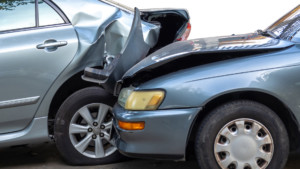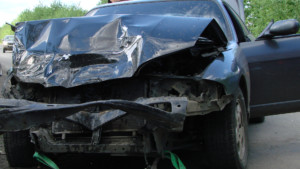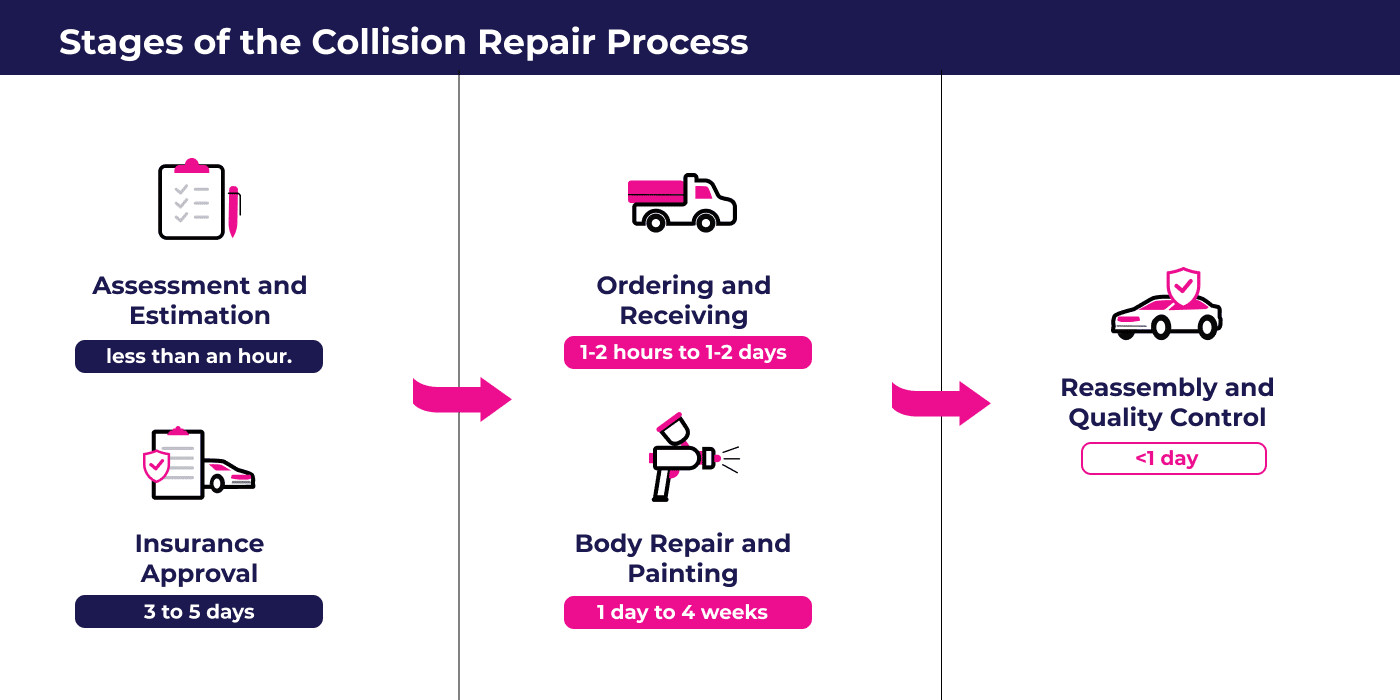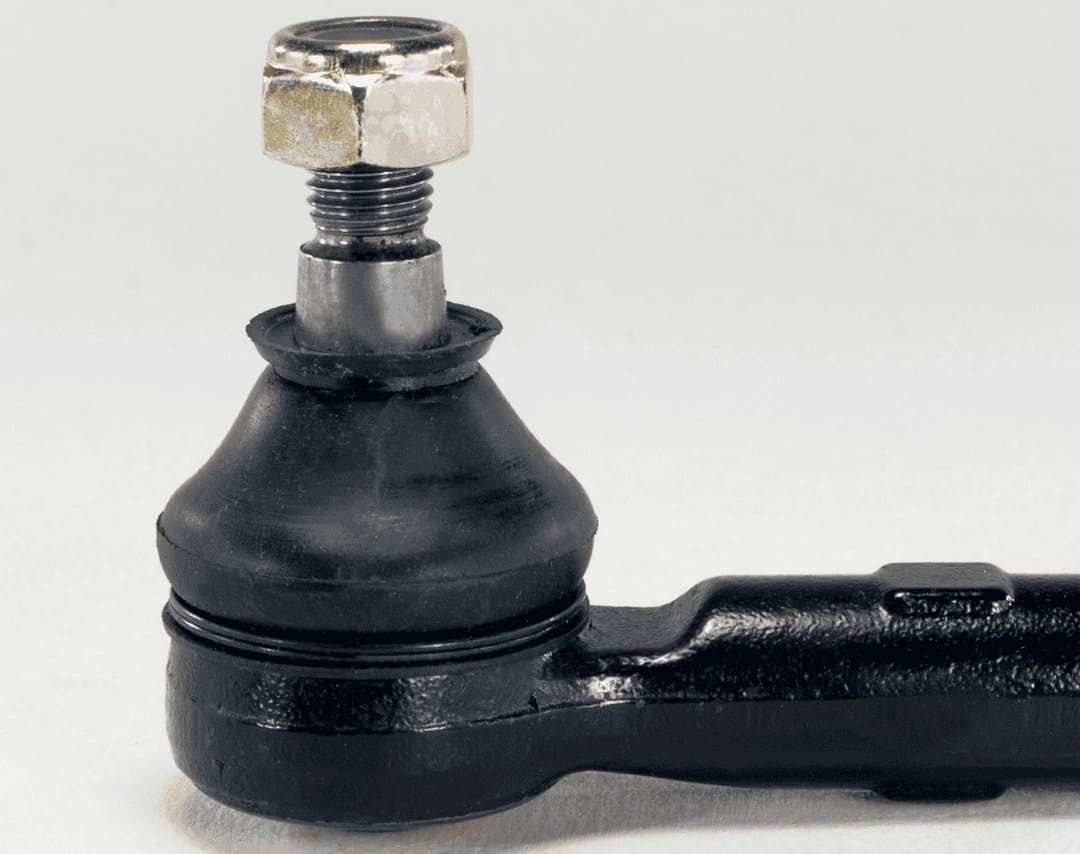How Long To Get Car Fixed After Accident?

How long to get car fixed after accident? Discover the factors influencing auto repair timelines and ways to expedite the process. CARDIAGTECH.NET offers insights and solutions for efficient vehicle repairs. Reduce downtime and get back on the road sooner with our expert guidance, focusing on collision repair time, auto body work duration, and vehicle restoration timeline.
1. Understanding Collision Repair Timelines
Experiencing a car accident is undoubtedly stressful, and the subsequent repair process can add to the anxiety. One of the most pressing questions vehicle owners have is: “How long will it take to get my car fixed?” The answer is not straightforward, as various factors influence the repair timeline. Let’s delve into the typical repair durations and the elements that affect them.
1.1 Average Collision Repair Time
The average time to repair a car after an accident can range from a few hours to several weeks, depending on the severity of the damage and other variables.
| Type of Collision Repair | Average Time to Fix |
|---|---|
| Minor Collision Repair | 1-3 days |
| Major Collision Repair | 1 to 3 weeks |
| Paintless Dent Repair | 1-2 days |
| Bumper Repair/Replacement | 1-3 days |
| Fender Repair/Replacement | 1-4 days |
| Door Repair/Replacement | 2-4 days |
| Glass Replacement | 1-2 days |
| Suspension Repair | 2-3 days |
| Frame Straightening | 4 days – 2 weeks |
| Paint Repair (minor) | 2-4 days |
| Paint Repair (major) | 1-2 weeks |
| Airbag Replacement | 2-5 days |
| Engine Repair/Replacement | 1-4 weeks |
| Full Vehicle Restoration | 4-8 weeks or longer |
This broad range highlights the importance of understanding the specific factors influencing your vehicle’s repair timeline. CARDIAGTECH.NET is here to guide you through these complexities.
1.2 Minor vs. Major Collision Repair Times
Distinguishing between minor and major collision repairs is crucial for setting realistic expectations.
Minor Collision Repair: These repairs typically take 1 to 3 days and involve cosmetic fixes like small dents, scratches, or minor bumper damage. These issues don’t affect the vehicle’s core structure and require minimal labor.
 car with a dent from a shopping cart
car with a dent from a shopping cart
Image alt: Small dent on a car door caused by a shopping cart, requiring minor collision repair.
Major Collision Repair: These repairs can take 1 to 3 weeks and involve more complex issues such as frame damage, mechanical problems, or airbag replacements. These repairs require specialized work and may involve waiting for parts.
 car with rear end damage, including a crushed trunk and a damaged bumper
car with rear end damage, including a crushed trunk and a damaged bumper
Image alt: Car with significant rear-end damage from a collision, indicative of major collision repair needs.
Severe Collision Damage: In cases of extensive frame damage or when hard-to-find parts are needed, repairs can extend beyond 3 weeks. The more severe the damage, the longer the repair time.
 car with severe frontend damage, including a crushed front end, crumpled hood, and broken windshield
car with severe frontend damage, including a crushed front end, crumpled hood, and broken windshield
Image alt: Car with severe front-end damage from a high-speed collision, necessitating extensive and prolonged repairs.
1.3 Stages of the Collision Repair Process
Understanding the collision repair process can provide clarity on why repairs take as long as they do. Here are the typical stages involved:
- Assessment and Estimation: The repair facility examines the damage, estimates the timeframe and cost, and provides an estimate to the vehicle owner.
- Insurance Approval: If an insurance policy is involved, the insurance company reviews and approves the estimate. This may involve some negotiation based on the required repairs and costs.
- Ordering and Receiving Parts: Depending on the damage and the vehicle’s make and model, the repair shop may need to order replacement parts.
- Body Repair and Painting: This involves restoring the vehicle to factory specifications, removing dents, replacing parts, and using premium paint to restore the vehicle’s aesthetic.
- Reassembly and Quality Control: Detail pieces and final moldings are put back on the vehicle, followed by a thorough inspection to ensure everything looks great and that all vehicle systems are checked for safety and performance.
 Stages of the Collision Repair Process
Stages of the Collision Repair Process
Image alt: Flowchart illustrating the stages of the collision repair process, from initial assessment to final quality control.
2. Factors Affecting Collision Repair Time
Several factors can influence the length of time it takes to repair a car after an accident. Understanding these factors can help you anticipate potential delays and plan accordingly.
2.1 Severity of Damage
The extent of the damage is a primary factor determining the repair time. Minor issues like dents and scratches are quicker to fix, while major repairs involving frame damage or mechanical issues take longer.
2.2 Availability of Replacement Parts
The availability of replacement parts can significantly impact the repair timeline. Common parts are usually readily available, but rare or custom parts can take several days or weeks to arrive. The choice between Original Equipment Manufacturer (OEM) parts and aftermarket parts can also affect the repair time.
2.3 Type of Vehicle
The type of vehicle can affect repair costs and timelines. Common vehicles like Toyota, Honda, Ford, and Chevrolet typically have readily available parts, making repairs faster and more affordable. Luxury or rare vehicles like Mercedes-Benz, BMW, Audi, Lexus, and Tesla require specialized parts and technicians, which can extend the repair time.
2.4 Insurance Company Involvement
When insurance is involved, the claim filing and approval process can add time to the repair timeline. Minor repairs are often quicker to handle out-of-pocket, while larger repairs require insurance claims, which can extend the repair time from days to weeks.
2.5 Repair Shop Workload
The workload of the auto repair shop can affect how long it takes to get your vehicle repaired. If the shop is busy, you may experience delays. Choosing a reputable collision repair shop is crucial because they provide quality work, fair pricing, and transparency.
 Factors Affecting Collision Repair Time
Factors Affecting Collision Repair Time
Image alt: Diagram showcasing various factors affecting collision repair time, including severity of damage, parts availability, and insurance involvement.
3. How to Expedite the Car Repair Process
While some factors are beyond your control, there are steps you can take to potentially expedite the car repair process and minimize the inconvenience.
3.1 Choose a Reputable Repair Shop
Selecting a reputable repair shop is crucial. Look for shops with certified technicians, positive reviews, and a commitment to customer service. A reliable shop will provide an accurate estimate, communicate effectively, and complete the repairs efficiently. CARDIAGTECH.NET recommends verifying certifications from organizations like ASE (National Institute for Automotive Service Excellence).
3.2 Understand Your Insurance Policy
Familiarize yourself with your insurance policy to understand what is covered and what the claims process entails. This knowledge can help you navigate the insurance approval process more smoothly. Insurers like State Farm and GEICO offer detailed online resources about their claims processes.
3.3 Communicate Effectively with the Repair Shop and Insurance Company
Maintain open and clear communication with both the repair shop and your insurance company. Promptly respond to any requests for information and ask questions to stay informed about the progress of the repairs. Use email or phone to keep a record of all communications.
3.4 Consider OEM vs. Aftermarket Parts
Discuss the option of using OEM (Original Equipment Manufacturer) versus aftermarket parts with the repair shop. While OEM parts may be more expensive, they often ensure a better fit and quality, potentially reducing the risk of future issues.
3.5 Be Proactive with Parts Ordering
If replacement parts are needed, inquire about their availability and estimated delivery time. If possible, explore options for expediting the parts ordering process. Some repair shops, like CARDIAGTECH.NET, may have partnerships with suppliers that can speed up delivery times.
4. Common Delays in Car Repair and How to Avoid Them
Even with the best planning, delays can occur during the car repair process. Understanding common causes of delays can help you anticipate and potentially mitigate them.
4.1 Parts Backorders
Parts backorders are a frequent cause of delays. This is especially true for newer models or vehicles with specialized parts. To avoid this, ask the repair shop to check the availability of parts before starting the repair and explore alternative suppliers if necessary.
4.2 Hidden Damage
Hidden damage discovered during the repair process can extend the timeline. Once the initial repairs are underway, technicians may uncover additional damage that was not visible during the initial assessment. Stay in close communication with the repair shop to address any new issues promptly.
4.3 Insurance Company Disputes
Disagreements with the insurance company over the scope or cost of repairs can cause delays. Provide all necessary documentation and be prepared to negotiate if necessary. Having a detailed estimate from a reputable repair shop can help support your case.
4.4 Mechanic Workload
A busy repair shop may have a backlog of vehicles waiting for repair. This can result in longer wait times. Inquire about the shop’s current workload and estimated completion time before authorizing the repairs.
5. Financial Aspects of Car Repair After an Accident
Understanding the costs associated with car repair after an accident is essential for budgeting and making informed decisions.
5.1 Average Costs of Common Repairs
The cost of car repair can vary widely depending on the type and extent of the damage. Here are some average costs for common repairs:
- Minor dent repair: $150 – $500
- Bumper replacement: $500 – $1,500
- Fender repair: $300 – $800
- Frame straightening: $500 – $2,000
- Engine repair: $1,000 – $5,000+
5.2 Insurance Coverage and Deductibles
Review your insurance policy to understand what is covered and what your deductible is. A deductible is the amount you pay out-of-pocket before your insurance coverage kicks in. Choose a repair shop that works directly with your insurance company to streamline the claims process.
5.3 Payment Options and Financing
Explore payment options and financing plans offered by the repair shop. Some shops offer financing options to help you manage the cost of repairs. CARDIAGTECH.NET can provide information about available financing options and payment plans.
6. The Role of CARDIAGTECH.NET in Expediting Car Repairs
CARDIAGTECH.NET plays a vital role in helping car owners navigate the repair process efficiently. Our range of diagnostic tools and equipment ensures that repair shops can quickly and accurately assess vehicle damage, leading to faster repair times.
6.1 Advanced Diagnostic Tools for Accurate Assessments
CARDIAGTECH.NET provides state-of-the-art diagnostic tools that allow repair shops to accurately assess the extent of damage to a vehicle. These tools can identify hidden damage and mechanical issues, ensuring that the repair estimate is comprehensive and accurate. This reduces the risk of delays caused by discovering additional damage later in the repair process.
6.2 Efficient Parts Ordering Systems
CARDIAGTECH.NET offers efficient parts ordering systems that streamline the process of sourcing and acquiring replacement parts. Our systems connect repair shops with a network of suppliers, ensuring that parts are delivered quickly. This reduces downtime and minimizes delays caused by parts backorders.
6.3 Training and Support for Repair Technicians
CARDIAGTECH.NET provides training and support for repair technicians, ensuring that they are equipped with the knowledge and skills to perform repairs efficiently and effectively. Our training programs cover the latest repair techniques and technologies, enabling technicians to complete repairs to the highest standards.
6.4 Partnering with Reputable Repair Shops
CARDIAGTECH.NET partners with a network of reputable repair shops that are committed to providing quality service and efficient repairs. Our partner shops meet stringent standards for certification, customer service, and repair quality. This ensures that car owners can trust that their vehicles are in good hands.
7. Legal Considerations After a Car Accident
After a car accident, understanding the legal aspects can help protect your rights and ensure a fair resolution.
7.1 Reporting the Accident
Report the accident to the appropriate authorities, such as the police, as soon as possible. Obtain a copy of the police report, as it may be needed for insurance claims and legal proceedings.
7.2 Documenting the Damage
Document the damage to your vehicle by taking photos and videos. These can be used as evidence when filing an insurance claim or pursuing legal action.
7.3 Seeking Medical Attention
Seek medical attention for any injuries sustained in the accident. Even if you don’t feel injured immediately, it’s important to get checked by a doctor, as some injuries may not be apparent right away.
7.4 Consulting with an Attorney
Consult with an attorney to understand your legal rights and options. An attorney can help you navigate the legal process and ensure that you receive fair compensation for your damages.
8. Maintaining Your Vehicle After Repairs
After your vehicle has been repaired, it’s important to maintain it properly to ensure its longevity and performance.
8.1 Regular Maintenance
Follow the manufacturer’s recommended maintenance schedule to keep your vehicle in good condition. This includes regular oil changes, tune-ups, and inspections.
8.2 Monitoring for New Issues
Keep an eye out for any new issues that may arise after the repairs. If you notice any problems, take your vehicle back to the repair shop for further inspection.
8.3 Protecting Your Investment
Protect your investment by taking steps to prevent future accidents and damage. This includes driving safely, avoiding distractions, and maintaining your vehicle properly.
9. Real-Life Examples of Car Repair Timelines
To provide a clearer understanding of car repair timelines, here are some real-life examples:
9.1 Minor Fender Bender
A driver backed into another car in a parking lot, causing minor damage to the fender. The repair involved smoothing out the dent and repainting the fender. The repair took 2 days to complete.
9.2 Rear-End Collision
A driver was rear-ended at a stoplight, causing damage to the bumper and trunk. The repair involved replacing the bumper and repairing the trunk. The repair took 1 week to complete.
9.3 Side-Impact Collision
A driver was involved in a side-impact collision, causing damage to the door and side panel. The repair involved replacing the door and repairing the side panel. The repair took 2 weeks to complete.
9.4 Major Engine Repair
A driver experienced engine failure, requiring a major engine repair. The repair involved rebuilding the engine. The repair took 3 weeks to complete.
10. Frequently Asked Questions About Car Repair After Accidents
Here are some frequently asked questions about car repair after accidents:
10.1 How Do I Choose a Reputable Repair Shop?
Look for shops with certified technicians, positive reviews, and a commitment to customer service. CARDIAGTECH.NET recommends verifying certifications from organizations like ASE (National Institute for Automotive Service Excellence).
10.2 What Should I Do if I’m Not Happy with the Repair Work?
Communicate your concerns to the repair shop and give them an opportunity to address the issues. If you’re still not satisfied, consider seeking a second opinion from another repair shop.
10.3 How Can I Get a Rental Car While My Car is Being Repaired?
Check your insurance policy to see if it covers rental car expenses. If so, work with the insurance company to arrange for a rental car.
10.4 What Should I Do if the Repair Shop Finds Additional Damage?
Stay in close communication with the repair shop to discuss any additional damage and the impact on the repair timeline and cost.
10.5 How Can I Prevent Future Accidents?
Drive safely, avoid distractions, and maintain your vehicle properly to prevent future accidents.
10.6 What if the Repair Costs Exceed the Value of My Car?
If the repair costs exceed the value of your car, the insurance company may declare it a total loss. In this case, you may receive a settlement for the value of the car.
10.7 How Does Insurance Affect the Repair Timeline?
Insurance claim processing can add time to the repair timeline due to claim filing and approval processes.
10.8 Can I Use Aftermarket Parts Instead of OEM Parts?
You can use aftermarket parts, but discuss the pros and cons with the repair shop. OEM parts often ensure a better fit and quality.
10.9 What Are Common Causes of Delays in Car Repair?
Common causes of delays include parts backorders, hidden damage, and insurance company disputes.
10.10 How Does CARDIAGTECH.NET Help Expedite Car Repairs?
CARDIAGTECH.NET provides advanced diagnostic tools, efficient parts ordering systems, and training and support for repair technicians to expedite car repairs.
Navigating the car repair process after an accident can be complex, but understanding the factors that affect repair timelines, costs, and legal considerations can help you make informed decisions. CARDIAGTECH.NET is committed to providing the tools, resources, and support you need to get back on the road as quickly and safely as possible.
Need expert advice on the best diagnostic tools to speed up your car repairs? Contact CARDIAGTECH.NET today at 276 Reock St, City of Orange, NJ 07050, United States or via Whatsapp at +1 (641) 206-8880. Visit our website CARDIAGTECH.NET for more information and to explore our range of products designed to enhance your repair efficiency. Let us help you minimize downtime and maximize your vehicle’s performance.




